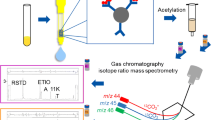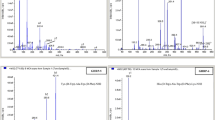Abstract
In the field of LC-MS, reversed phase liquid chromatography is the predominant method of choice for the separation of prohibited substances from various classes in sports drug testing. However, highly polar and charged compounds still represent a challenging task in liquid chromatography due to their difficult chromatographic behavior using reversed phase materials. A very promising approach for the separation of hydrophilic compounds is hydrophilic interaction liquid chromatography (HILIC). Despite its great potential and versatile advantages for the separation of highly polar compounds, HILIC is up to now not very common in doping analysis, although most manufacturers offer a variety of HILIC columns in their portfolio. In this study, a novel multi-target approach based on HILIC high resolution/high accuracy mass spectrometry is presented to screen for various polar stimulants, stimulant sulfo-conjugates, glycerol, AICAR, ethyl glucuronide, morphine-3-glucuronide, and myo-inositol trispyrophosphate after direct injection of diluted urine specimens. The usage of an effective online sample cleanup and a zwitterionic HILIC analytical column in combination with a new generation Hybrid Quadrupol-Orbitrap® mass spectrometer enabled the detection of highly polar analytes without any time-consuming hydrolysis or further purification steps, far below the required detection limits. The methodology was fully validated for qualitative and quantitative (AICAR, glycerol) purposes considering the parameters specificity; robustness (rRT < 2.0 %); linearity (R > 0.99); intra- and inter-day precision at low, medium, and high concentration levels (CV < 20 %); limit of detection (stimulants and stimulant sulfo-conjugates < 10 ng/mL; norfenefrine; octopamine < 30 ng/mL; AICAR < 10 ng/mL; glycerol 100 μg/mL; ETG < 100 ng/mL); accuracy (AICAR 103.8–105.5 %, glycerol 85.1–98.3 % at three concentration levels) and ion suppression/enhancement effects.






Similar content being viewed by others
References
WADA (2014) The 2014 Prohibited List International Standard. Available at: https://wada-main-prod.s3.amazonaws.com/resources/files/WADA-Revised-2014-Prohibited-List-EN.PDF. Accessed 13 Nov 2014
Guddat S, Solymos E, Orlovius A, Thomas A, Sigmund G, Geyer H, Thevis M, Schänzer W (2011) High-throughput screening for various classes of doping agents using a new ‘dilute-and-shoot’ liquid chromatography-tandem mass spectrometry multi-target approach. Drug Test Anal 3:836–850
Thörngren JO, Östervall F, Garle M (2008) A high-throughput multicomponent screening method for diuretics, masking agents, central nervous system (CNS) stimulants and opiates in human urine by UPLC–MS/MS. J Mass Spectrom 43:980–992
Badoud F, Grata E, Perrenoud L, Avois L, Saugy M, Rudaz S, Veuthey JL (2009) Fast analysis of doping agents in urine by ultra-high pressure liquid chromatography-quadrupole time-of-flight mass spectrometry: I screening analysis. J Chromatogr A 1216:4423–4433
Alpert A (1990) Hydrophilic-interaction chromatography for the separation of peptides, nucleic acids and other polar compounds. J Chromatogr 499:177–196
Olsen BA, Pack BW (2013) Hydrophilic interaction chromatography—a guide for practitioners. Wiley, New Jersey
McCalley D (2010) Study of the selectivity, retention mechanisms and performance of alternative silica-based stationary phases for separation of ionised solutes in hydrophilic interaction chromatography. J Chromatogr A 1217:3408–3417
Heaton J, Gray N, Cowan DA, Plumb RS, Legido-Quigley C, Smith NW (2012) Comparison of reversed-phase and hydrophilic interaction liquid chromatography for the separation of ephedrines. J Chromatogr A 1228:329–337
Gray N, Heaton J, Musenga A, Cowan DA, Plumb RS, Smith NW (2013) Comparison of reversed-phase and hydrophilic interaction liquid chromatography for the quantification of ephedrines using medium-resolution accurate mass spectrometry. J Chromatogr A 1289:37–46
Marclay F, Saugy M (2010) Determination of nicotine and nicotine metabolites in urine by hydrophilic interaction chromatography-tandem mass spectrometry: potential use of smokeless tobacco products by ice hockey players. J Chromatogr A 48:7528–7538
Görgens C, Guddat S, Schänzer W, Thevis M (2014) Screening and confirmation of myo-inositol trispyrophosphate (ITPP) in human urine by hydrophilic interaction liquid chromatography high resolution / high accuracy mass spectrometry for doping control purposes. Drug Test Anal 6:1102–1107
Kolmonen M, Leinonen A, Kuuranne T, Pelander A, Ojanpera I (2010) Hydrophilic interaction liquid chromatography and accurate mass measurement for quantification and confirmation of morphine, codeine and their glucuronide conjugates in human urine. J Chromatogr B Analyt Technol Biomed Life Sci 29:2959–2966
Mazzarino M, Fiacco I, de la Torre X, Botre F (2011) Screening and confirmation analysis of stimulants, narcotics and beta-adrenergic agents in human urine by hydrophilic interaction liquid chromatography coupled to mass spectrometry. J Chromatogr A 45:8156–8167
Orlovius AK, Guddat S, Parr MK, Kohler M, Gutschow M, Thevis M, Schänzer W (2009) Terbutaline sulfoconjugate: characterization and urinary excretion monitored by LC/ESI-MS/MS. Drug Test Anal 1:568–575
Parr MK, Orlovius AK, Guddat S, Gütschow M, Thevis M, Schänzer W (2007) Sulfoconjugates of heavy volatile nitrogen containing doping substance for improved LC-MS/MS screening. Recent Advances in Doping Analysis, Sportverl Strauß, Köln 15:97–102
WADA (2014) International Standard for Laboratories. Available at: https://wada-main-prod.s3.amazonaws.com/resources/files/WADA-ISL-2015-Final-v8.0-EN.pdf. Accessed: 13 Nov 2014
WADA (2014) Technical Document - TD2014MRPL. https://wada-main-prod.s3.amazonaws.com/resources/files/WADA-TD2014MRPL-v1-Minimum-Required-Performance-Levels-EN.pdf. Accessed: 13 Nov 2014
Thevis M, Sigmund G, Geyer H, Schänzer W (2010) Stimulants and doping in sport. Endocrinol Metab Clin North Am 39:89–105
Dring LG, Smith RL, Williams RT (1970) Metabolic fate of amphetamine in Man and other species. Biochem J 116:425–435
Hayakawa K, Miyoshi Y, Kurimoto H, Matsushima Y, Takayama N, Tanaka S, Miyazaki M (1993) Simultaneous determination of methamphetamine and its metabolites in the urine samples of abusers by high-performance liquid-chromatography with chemiluminescence detection. Biol Pharm Bull 16:817–821
Shimosato K, Tomita M, Ijiri I (1986) Urinary-excretion of P-hydroxylated methamphetamine metabolites in man. Arch Toxicol 59:135–140
Shima N, Kamata HT, Katagi M, Tsuchihashi H (2006) Urinary excretion of the main metabolites of methamphetamine, including p-hydroxymethamphetamine-sulfate and p-hydroxymethamphetamine-glucuronide, in humans and rats. Xenobiotica 36:259–267
Shima N, Tsutsumi H, Kamata T, Nishikawa M, Katagi M, Miki A, Tsuchihashi H (2006) Direct determination of glucuronide and sulfate of p-hydroxymethamphetamine in methamphetamine users' urine. J Chromatogr B Anal Technol Biomed Life Sci 830:64–70
Hengstmann JH, Weyand U, Dengler HJ (1975) Physiological disposition of etilefrine in man. Eur J Clin Pharmacol 9:179–187
Kauert G, Angermann C, Lex H, Spes C (1988) Clinical pharmacokinetics after a single oral dose of oxilofrine. Int J Clin Pharmacol Res 8:307–314
Verho M, Malerczyk V, Kauert G, Lorenz H (1988) Dose linearity and relative bioavailability testing of oxilofrine, a sympathomimetic drug, in healthy-volunteers. Int J Clin Pharmacol Res 8:211–215
Hengstmann JH, Konen W, Konen C, Eichelbaum M, Dengler HJ (1974) The physiological disposition of p-octopamine in man. Naunyn-Schmiedeberg’s Arch Pharmacol 283:93–106
WADA (2014) Technical Document – TD2014DL. https://wada-main-prod.s3.amazonaws.com/resources/files/WADA-TD2014DL-v1-Decision-Limits-for-the-Quantification-of-Threshold-Substances-EN.pdf. Accessed: 13 Nov 2014
Thevis M, Guddat S, Flenker U, Schänzer W (2008) Quantitative analysis of urinary glycerol levels for doping control purposes using gas-mass spectrometry. Eur J Mass Spectrom 14:117–125
Narkar VA, Downes M, Yu RT, Embler E, Wang YX, Banayo E, Mihaylova MM, Nelson MC, Zou Y, Juguilon H, Kang H, Shaw RJ, Evans RM (2008) AMPK and PPARdelta agonists are exercise mimetics. Cell 134:405–415
Thevis M, Thomas A, Kohler M, Beuck S, Schänzer W (2009) Emerging drugs: mechanism of action, mass spectrometry and doping control analysis. J Mass Spectrom 44:442–460
Barre L, Richardson C, Hirshman MF, Brozinick J, Fiering S, Kemp BE, Goodyear LJ, Witters LA (2007) Genetic model for the chronic activation of skeletal muscle AMP-activated protein kinase leads to glycogen accumulation. Am J Physiol Endocrinol Metab 292:E802–E811
Thomas A, Beuck S, Eickhoff JC, Guddat S, Krug O, Kamber M, Schänzer W, Thevis M (2010) Quantification of urinary AICAR concentrations as a matter of doping controls. Anal Bioanal Chem 396:2899–2908
Piper T, Thomas A, Baume N, Sobolevsky T, Saugy M, Rodchenkov G, Schänzer W, Thevis M (2014) Determination of 13C/12C ratios of endogenous urinary 5-amino-imidazole-4-carboxamide 1β-D-ribofuranoside (AICAR). Rapid Commun Mass Spectrom 28:1194–1202
Falk O, Palonek E, Björkhem I (1988) Effect of ethanol on the ratio between testosterone and epitestosterone in urine. Clin Chem 34:1462–1464
Geyer H, Mareck U, Haenelt N, Schänzer W (2009) Atypical steroid profiles in connection with ethanol findings in urine. Recent advances in doping analysis, sportverl. Strauß, Köln 17:261–264
Große J, Anielski P, Sachs H, Thieme D (2009) Ethylglucuronide as a potential marker for alcohol-induced elevation of urinary testosterone/epitestosterone ratios. Drug Test Analysis 1:526–530
Görgens C, Guddat S, Thomas A, Geyer H, Schänzer W (2011) Identification and quantitative determination of long-term alcohol markers ethylglucuronide and ethylsulfate in human urine by LC-MS/MS in doping control analysis. Recent advances in doping analysis, sportverl. Strauß, Köln 19:209–312
Thieme D, Große J, Keller GM (2011) Urinary concentrations of ethyl glucuronide and ethyl sulfate as thresholds to determine potential ethanol-induced alteration of steroid profiles. Drug Test Analysis 3:851–856
Hasselström J, Säwe J (1993) Morphine pharmacokinetics and metabolism in humans: enterohepatic cycling and relative contribution of metabolites to active opioid concentrations. Clin Pharmacokinet 24:344–354
Osborne R, Joel S, Trew D, Slevin M (1990) Morphine and metabolite behavior after different routes of morphine administration: demonstration of the importance of the active metabolite morphine-6-glucuronide. Clin Pharmacol Ther 47:12–19
Kilpatrick GJ, Smith TW (2005) Morphine-6-glucuronide: actions and mechanisms. Med Res Rev 25:521–44
Fylaktakidou KC, Lehn JM, Greferath RC, Nicolau C (2005) Inositol tripyrophosphate: a new membrane permeant allosteric effector of haemoglobin. Bioorg Med Chem Lett 15:1605–1608
Duarte CD, Greferath R, Nicolau C, Lehn JM (2010) Myo-inositol trispyrophosphate: a novel allosteric effector of hemoglobin with high permeation selectivity across the red blood cell plasma membrane. Chem Bio Chem 11:2543–2548
Suth J (2004) Efaproxiral: a novel radiation sensitiser. Expert Opin Investig Drugs 13:543–550
Acknowledgments
This project has been carried out with the support of Antidoping Switzerland, the Federal Ministry of the Interior of the Federal Republic of Germany and the Manfred Donike Institut für Dopinganalytik e.V.
Author information
Authors and Affiliations
Corresponding author
Rights and permissions
About this article
Cite this article
Görgens, C., Guddat, S., Orlovius, AK. et al. “Dilute-and-inject” multi-target screening assay for highly polar doping agents using hydrophilic interaction liquid chromatography high resolution/high accuracy mass spectrometry for sports drug testing. Anal Bioanal Chem 407, 5365–5379 (2015). https://doi.org/10.1007/s00216-015-8699-x
Received:
Revised:
Accepted:
Published:
Issue Date:
DOI: https://doi.org/10.1007/s00216-015-8699-x




